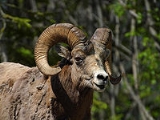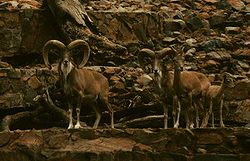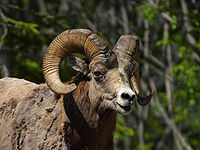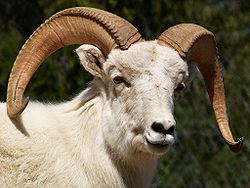
Ovis
Encyclopedia
Ovis is a genus
of mammal
s, part of the goat-antelope subfamily of the ruminant
family
Bovidae. Its five or more highly gregarious species
are known as sheep. The domestic sheep
is one member of the genus, and is thought to be descended from the wild mouflon
of central
and southwest Asia
.
or mob. The term herd
is also occasionally used in this sense. There is a large number of specialist terms relating to domestic sheep.
s on the face and feet. Communication through the scent glands is not well understood but is thought to be important for sexual signaling. Males can smell females that are fertile and ready to mate, and rams mark their territories by rubbing scent on to rocks. Like other ruminant
s, they have a four-chambered stomach
which plays a vital role in digesting
, regurgitating
, and redigesting food. Domestic sheep are used for their wool
, milk
, and meat
(which is called mutton
or lamb
).
es, as well as other plants and lichens. Like other bovid
s, their digestive system enables them to digest and live on low-quality, rough plant materials. Sheep conserve water well and can live in fairly dry environments. The bodies of wild sheep (and some domestic breeds) are covered by a coat of thick hair
to protect them from cold. This coat contains long, stiff hairs, called kemps, over a short woolly undercoat, which grows in autumn and is shed in spring. It is this woolly undercoat which has been developed in many domestic sheep breeds into a fleece of long wool
; this replaces the kemp hairs in these breeds. The fleece covers the body (in a few breeds also the face and legs) and is used for fibre.
Sheep are social animals and live in groups, called flocks. This helps them to avoid predators and also helps them stay warm in bad weather by huddling together. Flocks of sheep need to keep moving to find new grazing areas and more favourable climate as the seasons change. In each flock, there is a sheep, usually a mature ram, which the others follow as a leader.
In wild sheep, both rams and ewes have horn
s, while in domestic sheep (depending upon breed) horns may be present in both rams and ewes, in rams only, or in neither. Rams' horns may be very large – those of a mature bighorn ram can weigh 14 kilograms (31 lb) – as much as the bones of the rest of its body put together. Rams use their horns to fight with each other for dominance and for the right to mate with females. In most cases, they do not injure each other because they hit each other head to head and their curved horns do not strike each other's bodies. They are also protected by having very thick skin and a double-layered skull.
Wild sheep have very keen senses of sight
and hearing
. When detecting predators, wild sheep most often flee, usually uphill to higher ground. However, they can also fight back. The Dall sheep has been known to butt wolves off the face of cliffs.
Genus
In biology, a genus is a low-level taxonomic rank used in the biological classification of living and fossil organisms, which is an example of definition by genus and differentia...
of mammal
Mammal
Mammals are members of a class of air-breathing vertebrate animals characterised by the possession of endothermy, hair, three middle ear bones, and mammary glands functional in mothers with young...
s, part of the goat-antelope subfamily of the ruminant
Ruminant
A ruminant is a mammal of the order Artiodactyla that digests plant-based food by initially softening it within the animal's first compartment of the stomach, principally through bacterial actions, then regurgitating the semi-digested mass, now known as cud, and chewing it again...
family
Family (biology)
In biological classification, family is* a taxonomic rank. Other well-known ranks are life, domain, kingdom, phylum, class, order, genus, and species, with family fitting between order and genus. As for the other well-known ranks, there is the option of an immediately lower rank, indicated by the...
Bovidae. Its five or more highly gregarious species
Species
In biology, a species is one of the basic units of biological classification and a taxonomic rank. A species is often defined as a group of organisms capable of interbreeding and producing fertile offspring. While in many cases this definition is adequate, more precise or differing measures are...
are known as sheep. The domestic sheep
Domestic sheep
Sheep are quadrupedal, ruminant mammals typically kept as livestock. Like all ruminants, sheep are members of the order Artiodactyla, the even-toed ungulates. Although the name "sheep" applies to many species in the genus Ovis, in everyday usage it almost always refers to Ovis aries...
is one member of the genus, and is thought to be descended from the wild mouflon
Mouflon
The mouflon is a subspecies group of the wild sheep Ovis aries. Populations of Ovis aries can be partitioned into the mouflons and urials or arkars...
of central
Central Asia
Central Asia is a core region of the Asian continent from the Caspian Sea in the west, China in the east, Afghanistan in the south, and Russia in the north...
and southwest Asia
Southwest Asia
Western Asia, West Asia, Southwest Asia or Southwestern Asia are terms that describe the westernmost portion of Asia. The terms are partly coterminous with the Middle East, which describes a geographical position in relation to Western Europe rather than its location within Asia...
.
Terminology
Female sheep are called ewes, males are called rams (sometimes also called bucks or tups) and young sheep are called lambs. The adjective applying to sheep is ovine and the collective term for sheep is flockHerd
Herd refers to a social grouping of certain animals of the same species, either wild or domestic, and also to the form of collective animal behavior associated with this or as a verb, to herd, to its control by another species such as humans or dogs.The term herd is generally applied to mammals,...
or mob. The term herd
Herd
Herd refers to a social grouping of certain animals of the same species, either wild or domestic, and also to the form of collective animal behavior associated with this or as a verb, to herd, to its control by another species such as humans or dogs.The term herd is generally applied to mammals,...
is also occasionally used in this sense. There is a large number of specialist terms relating to domestic sheep.
Characteristics
Sheep are usually stockier than most other bovines, and their horns are usually divergent and curled into a spiral. Sheep have scent glandScent gland
Scent glands are found in the genital area of most mammals and in various other parts of the body, such as the underarms of humans and the preorbital glands of deer and muskox. They produce a semi-viscous fluid which contains pheromones. These odor-messengers indicate information such as status,...
s on the face and feet. Communication through the scent glands is not well understood but is thought to be important for sexual signaling. Males can smell females that are fertile and ready to mate, and rams mark their territories by rubbing scent on to rocks. Like other ruminant
Ruminant
A ruminant is a mammal of the order Artiodactyla that digests plant-based food by initially softening it within the animal's first compartment of the stomach, principally through bacterial actions, then regurgitating the semi-digested mass, now known as cud, and chewing it again...
s, they have a four-chambered stomach
Stomach
The stomach is a muscular, hollow, dilated part of the alimentary canal which functions as an important organ of the digestive tract in some animals, including vertebrates, echinoderms, insects , and molluscs. It is involved in the second phase of digestion, following mastication .The stomach is...
which plays a vital role in digesting
Digestion
Digestion is the mechanical and chemical breakdown of food into smaller components that are more easily absorbed into a blood stream, for instance. Digestion is a form of catabolism: a breakdown of large food molecules to smaller ones....
, regurgitating
Regurgitation (digestion)
Regurgitation is the expulsion of material from the mouth, pharynx, or esophagus, usually characterized by the presence of undigested food or blood.Regurgitation is used by a number of species to feed their young...
, and redigesting food. Domestic sheep are used for their wool
Wool
Wool is the textile fiber obtained from sheep and certain other animals, including cashmere from goats, mohair from goats, qiviut from muskoxen, vicuña, alpaca, camel from animals in the camel family, and angora from rabbits....
, milk
Milk
Milk is a white liquid produced by the mammary glands of mammals. It is the primary source of nutrition for young mammals before they are able to digest other types of food. Early-lactation milk contains colostrum, which carries the mother's antibodies to the baby and can reduce the risk of many...
, and meat
Meat
Meat is animal flesh that is used as food. Most often, this means the skeletal muscle and associated fat and other tissues, but it may also describe other edible tissues such as organs and offal...
(which is called mutton
Lamb (food)
Lamb, mutton, and hogget are the meat of domestic sheep. The meat of a sheep in its first year is lamb; that of a juvenile sheep older than 1 year is hogget; and the meat of an adult sheep is mutton....
or lamb
Lamb (food)
Lamb, mutton, and hogget are the meat of domestic sheep. The meat of a sheep in its first year is lamb; that of a juvenile sheep older than 1 year is hogget; and the meat of an adult sheep is mutton....
).
Species
Five species and numerous subspecies of sheep are currently recognised, although some subspecies have also been considered full species. The following are the main ones:  |
Ovis ammon | Argali Argali The argali, or the mountain sheep is a wild sheep, which roams the highlands of Central Asia . It is the biggest wild sheep, standing at the shoulder, measuring long and weighing , with a maximum known weight of... |
.jpg) |
Ovis aries aries | Domestic sheep Domestic sheep Sheep are quadrupedal, ruminant mammals typically kept as livestock. Like all ruminants, sheep are members of the order Artiodactyla, the even-toed ungulates. Although the name "sheep" applies to many species in the genus Ovis, in everyday usage it almost always refers to Ovis aries... |
 |
Ovis orientalis orientalis group | Mouflon Mouflon The mouflon is a subspecies group of the wild sheep Ovis aries. Populations of Ovis aries can be partitioned into the mouflons and urials or arkars... |
 |
Ovis orientalis vignei group | Urial Urial The Urial , also known as the Arkars or Shapo, is a subspecies group of the wild sheep Ovis orientalis. Noticeable features are the reddish-brown long fur that fades during winter; males are characterized by a black ruff stretching from the neck to the chest and large horns. It is found in western... |
 |
Ovis canadensis | Bighorn sheep Bighorn Sheep The bighorn sheep is a species of sheep in North America named for its large horns. These horns can weigh up to , while the sheep themselves weigh up to . Recent genetic testing indicates that there are three distinct subspecies of Ovis canadensis, one of which is endangered: Ovis canadensis sierrae... |
 |
Ovis dalli | Dall Sheep Dall Sheep The Dall sheep , Ovis dalli, is a species of sheep native to northwestern North America, ranging from white to slate brown in color and having curved yellowish brown horns... |
| Ovis nivicola | Snow sheep Snow sheep The snow sheep , or Siberian bighorn sheep, is a species of sheep, which comes from the mountainous areas in the northeast of Siberia. One subspecies, the Putorana Snow Sheep lives isolated from the other forms in the Putoran mountains... |
Behaviour
Wild sheep are mostly found in hilly or mountainous habitats. They are fairly small compared to other ungulates; in most species adults weigh less than 100 kilograms (220.5 lb). Their diet consists mainly of grassGrass
Grasses, or more technically graminoids, are monocotyledonous, usually herbaceous plants with narrow leaves growing from the base. They include the "true grasses", of the Poaceae family, as well as the sedges and the rushes . The true grasses include cereals, bamboo and the grasses of lawns ...
es, as well as other plants and lichens. Like other bovid
Bovid
A bovid is any of almost 140 species of cloven-hoofed ruminant mammal at least the males of which bear characteristic unbranching horns covered in a permanent sheath of keratin....
s, their digestive system enables them to digest and live on low-quality, rough plant materials. Sheep conserve water well and can live in fairly dry environments. The bodies of wild sheep (and some domestic breeds) are covered by a coat of thick hair
Hair
Hair is a filamentous biomaterial, that grows from follicles found in the dermis. Found exclusively in mammals, hair is one of the defining characteristics of the mammalian class....
to protect them from cold. This coat contains long, stiff hairs, called kemps, over a short woolly undercoat, which grows in autumn and is shed in spring. It is this woolly undercoat which has been developed in many domestic sheep breeds into a fleece of long wool
Wool
Wool is the textile fiber obtained from sheep and certain other animals, including cashmere from goats, mohair from goats, qiviut from muskoxen, vicuña, alpaca, camel from animals in the camel family, and angora from rabbits....
; this replaces the kemp hairs in these breeds. The fleece covers the body (in a few breeds also the face and legs) and is used for fibre.
Sheep are social animals and live in groups, called flocks. This helps them to avoid predators and also helps them stay warm in bad weather by huddling together. Flocks of sheep need to keep moving to find new grazing areas and more favourable climate as the seasons change. In each flock, there is a sheep, usually a mature ram, which the others follow as a leader.
In wild sheep, both rams and ewes have horn
Horn (anatomy)
A horn is a pointed projection of the skin on the head of various animals, consisting of a covering of horn surrounding a core of living bone. True horns are found mainly among the ruminant artiodactyls, in the families Antilocapridae and Bovidae...
s, while in domestic sheep (depending upon breed) horns may be present in both rams and ewes, in rams only, or in neither. Rams' horns may be very large – those of a mature bighorn ram can weigh 14 kilograms (31 lb) – as much as the bones of the rest of its body put together. Rams use their horns to fight with each other for dominance and for the right to mate with females. In most cases, they do not injure each other because they hit each other head to head and their curved horns do not strike each other's bodies. They are also protected by having very thick skin and a double-layered skull.
Wild sheep have very keen senses of sight
Visual perception
Visual perception is the ability to interpret information and surroundings from the effects of visible light reaching the eye. The resulting perception is also known as eyesight, sight, or vision...
and hearing
Hearing (sense)
Hearing is the ability to perceive sound by detecting vibrations through an organ such as the ear. It is one of the traditional five senses...
. When detecting predators, wild sheep most often flee, usually uphill to higher ground. However, they can also fight back. The Dall sheep has been known to butt wolves off the face of cliffs.
See also
- Aries, the RamAries (astrology)Aries is the first astrological sign in the Zodiac, which spans the zodiac between the zero degree and the 29th degree of celestial longitude. The Sun enters Aries when it reaches the northern vernal equinox, which is usually on March 21 each year, and remains in this sign until around April 20...
(astrological sign) - Barbary SheepBarbary sheepThe Barbary Sheep is a species of caprid native to rocky mountains in North Africa. Six subspecies have been described. Although it is rare in its native North Africa, it has been introduced to North America, southern Europe and elsewhere...
(Ammotragus lervia), another type of goat antelopeGoat antelopeA goat-antelope or caprid is any of the species of mostly medium-sized bovids that make up the subfamily Caprinae , part of the Bovidae family of ruminants...
, not closely related to Ovis sheep. - Blue sheep or bharal (Pseodois), two species of goat antelopeGoat antelopeA goat-antelope or caprid is any of the species of mostly medium-sized bovids that make up the subfamily Caprinae , part of the Bovidae family of ruminants...
s, not closely related to Ovis sheep. - Domestic sheepDomestic sheepSheep are quadrupedal, ruminant mammals typically kept as livestock. Like all ruminants, sheep are members of the order Artiodactyla, the even-toed ungulates. Although the name "sheep" applies to many species in the genus Ovis, in everyday usage it almost always refers to Ovis aries...
- Glossary of sheep husbandryGlossary of sheep husbandryThe raising of domestic sheep has occurred in nearly every inhabited part of the globe, and the variations in cultures and languages which have kept sheep has produced a vast lexicon of unique terminology used to describe sheep husbandry...
- List of sheep breeds
- Sheep husbandrySheep husbandrySheep husbandry is a subcategory of animal husbandry specifically dealing with the raising and breeding of domestic sheep. Sheep farming is primarily based on raising lambs for meat, or raising sheep for wool. Sheep may also be raised for milk or to sell to other farmers.-Shelter and...
External links
- Miller, S. 1998. "Sheep and Goats". United States Department of Agriculture, Foreign Agricultural Service
- Oklahoma State University (OSU). 2003 Breeds of Livestock: Sheep Retrieved January 13, 2007
- Huffman, B. 2006. The Ultimate Ungulate Page Website Retrieved January 13, 2007

